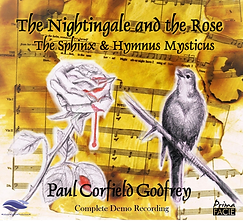
The Nightingale and the Rose, The Sphinx & Hymnus Mysticus
Press Release
Those who have enjoyed the contributions of Angharad Morgan as Lúthien and Nienor to Paul Corfield Godfrey’s cycle of epic scenes based on J R R Tolkien’s The Silmarillion (as featured on recent Prima Facie CDs) will be delighted by her assumption of the title role in The Nightingale and the Rose by the same composer. This operatic fable, based on a fairy story by Oscar Wilde, highlights the differences between the diametrically opposed perceptions of Love represented by the emotionally committed world of nature and the artificial monetary valuations of society. The text draws entirely from Wilde’s original, without any additions from other sources, and lasts around three-quarters of an hour. It features other soloists from Welsh National Opera, together with an orchestra drawn from live sampled performances which have been carefully balanced and adjusted in collaboration with the composer to obtain as close a result to the sound of an actual orchestra as possible, with results that Brian Wilson writing for MusicWeb International described as “completely convincing”. The work was originally written in 1976 but, apart from excerpts, has not been performed complete before now; the recording was originally scheduled for the composer’s seventieth birthday in 2020, but has been delayed by the recent pandemic.
To complete the CD we also present a further setting of Oscar Wilde in the shape of verses extracted from his narrative poem The Sphinx; and a short cantata entitled Hymnus Mysticus based on poems by Aleister Crowley, another writer of the era whose unconventional lifestyle resulted in ostracism and exile. The booklet includes an essay by the composer and complete texts of all the works.
Reviews of previous Volante Opera recordings of the music of Paul Corfield Godfrey have continued to garner ecstatic reviews from critics, including the following in Fanfare from Marc Medwin: “…heretofore, I have been entirely ignorant of Paul Corfield Godfrey’s work. More’s the pity…I am eager to enter again into this lush, sometimes harsh and epic universe of tone and word-painting.”
For reviews of the recording please visit the composer's website (link at the bottom of this page.
Cast and Creative
THE NIGHTINGALE AND THE ROSE
Cast (in order of singing):
The Student (Tenor): Simon Crosby Buttle
The Nightingale (Soprano): Angharad Morgan
The Green Lizard/The Yellow Rose Tree (Baritone): Julian Boyce
The Butterfly/The White Rose Tree (Mezzo): Helen Greenaway
The Daisy/The Red Rose Tree (Bass): Jasey Hall
The Beloved: Sophie Yelland
Chorus: Paula Greenwood/Emma Mary Llewellyn/Sophie Yelland/Helen Greenaway/Simon Crosby Buttle/David Fortey/
Julian Boyce/Jasey Hall
THE SPHINX
Baritone Solo: Julian Boyce
Chorus: Angharad Morgan/Emma Mary Llewellyn/Sophie Yelland/Helen Greenaway/Simon Crosby Buttle/David Fortey/
Julian Boyce/Jasey Hall
HYMNUS MYSTICUS
Soprano Solo: Emma Mary Llewellyn
Baritone Solo: Julian Boyce
Chorus: Angharard Morgan/Emma Mary Llewellyn/Sophie Yelland/Helen Greenaway/Simon Crosby Buttle/David Fortey/
Julian Boyce/Jasey Hall
Production and engineering:
Volante Opera Productions ©2022
Music published by:
Zarathustra Music ©2022
Artwork by:
Kimbo ©2022
Texts:
Oscar Wilde & Aleister Crowley
Booklet and notes:
Volante Opera Productions and Paul Corfield Godfrey ©2022
All artists appear by arrangement with Welsh National Opera
For more information and analysis please visit the composer's website (link at the bottom of this page)
Demo Recording Information
The recording is produced using Reaper software and is utilising the Eastwest Software/Quantum Leap Symphonic Orchestra sampled instruments.
The main parts are all be recorded using different professional singers with some doubling.
The Chorus was recorded two per voice part which accommodates the splits in the parts. Each of these voices, due to the limited space and equipment, is recorded individually and post processed to fit with the others. This is the method we use when creating learning tracks for choirs, as it gives us the opportunity to isolate parts and fix problems without having to have everyone back to re-record.

